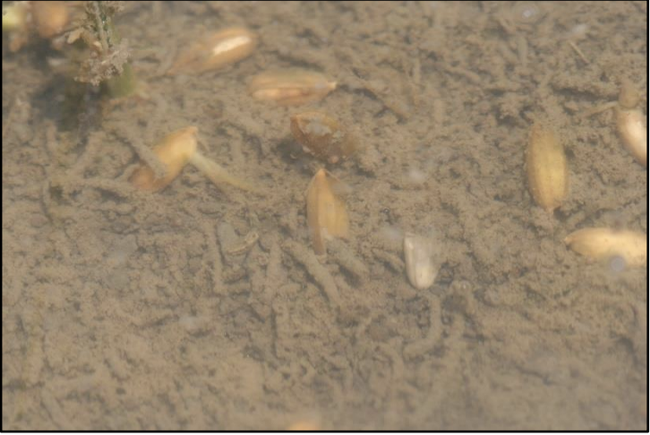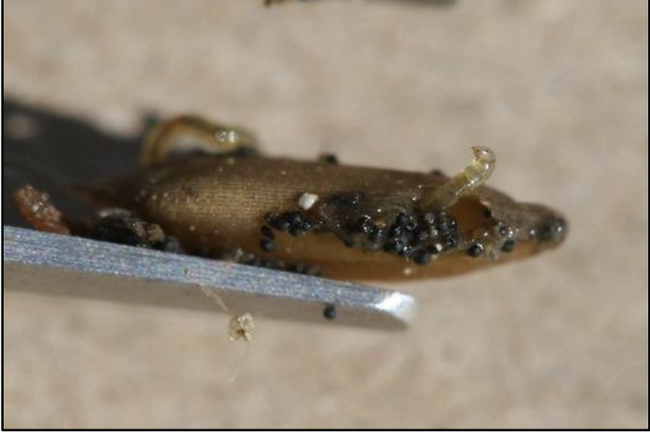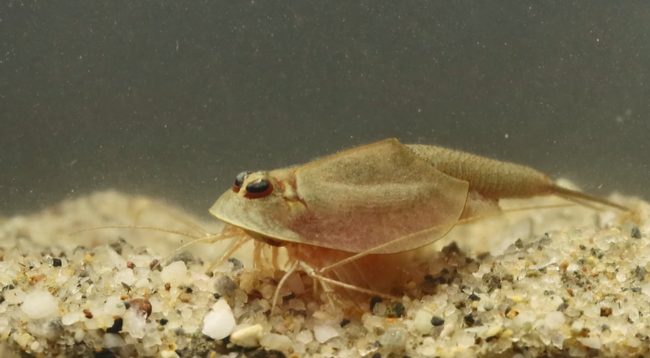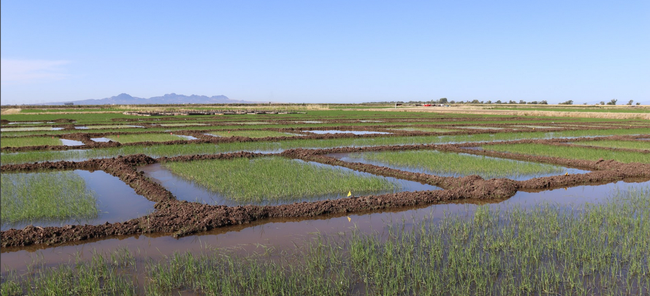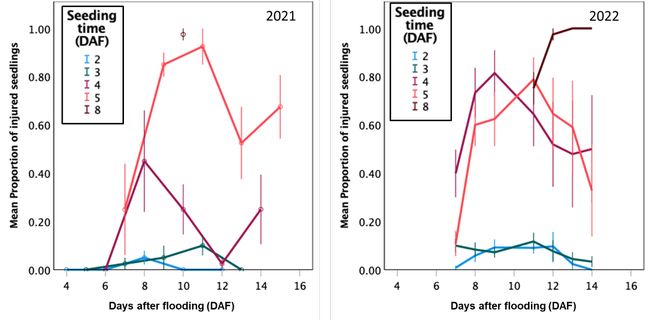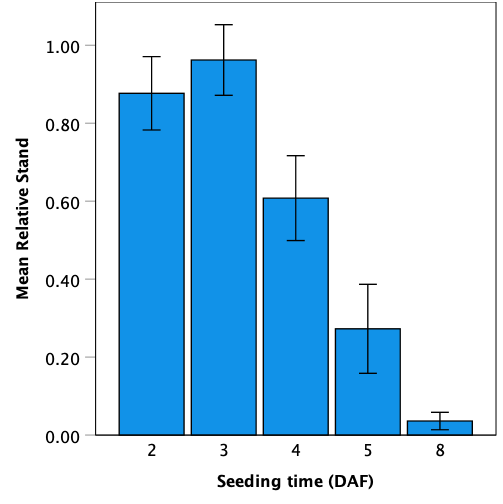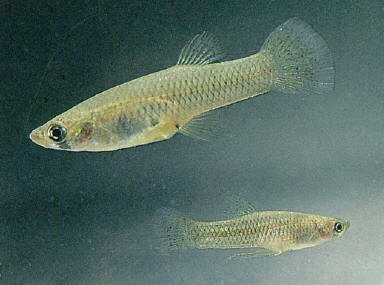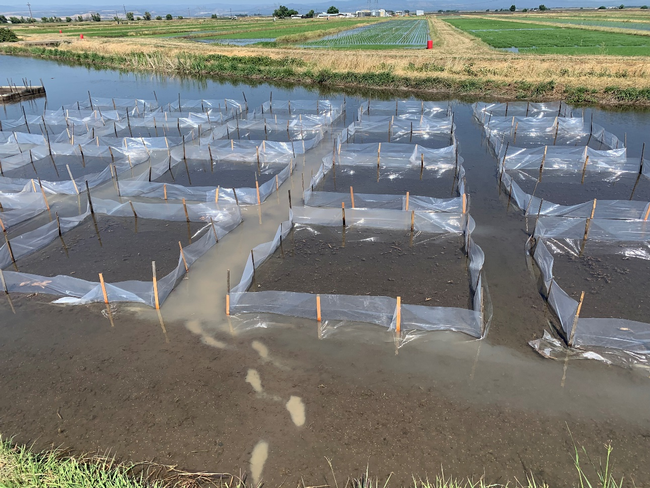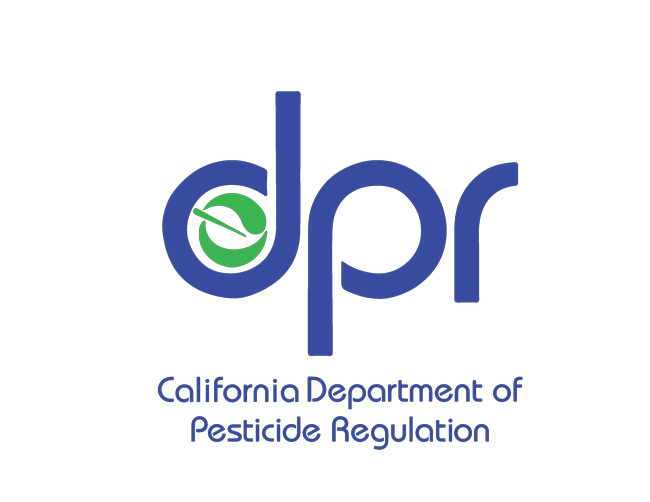- Author: Whitney Brim-DeForest,
- Editor: Taiyu Guan
- Editor: Consuelo Baez Vega
PCAs and growers were very creative and timely in planning and applying products this year, and control was good in many fields. The two most widespread weed control problems that I noticed this year were the watergrass complex and sprangletop. We have widespread resistance, but control issues this year were likely also related to the wet spring, as well as colder temperatures which resulted in different emergence timings and weed growth patterns as compared to other years.
Propanil Usage and Over-Reliance as a Tool
Propanil is a powerful tool in our herbicide arsenal in California rice. It has wide-spectrum control, controlling many grass, sedge, and broadleaf species.
However, there are several weed species that are already resistant to propanil, including smallflower umbrella sedge and ricefield bulrush (roughseed). As a reminder, resistance is likely to occur when we apply the same mode of action or same herbicide, more than once in a season, or over consecutive years, over more than one season. In both smallflower and bulrush, we have populations that are multiple-resistant to propanil and another herbicide mode of action (mostly ALS-inhibitors, like Granite GR/SC,Londax, and Halomax). This occurs because propanil is typically used as the season's last clean-up spray. If a weed is sprayed with an herbicide early in the season, but is resistant to that herbicide, and then is sprayed later in the season with propanil, there is a possibility that the weed may be resistant to propanil as well (naturally occurs in the population). When we always use propanil as the cleanup spray, we increase the chances of having weed species that are resistant to multiple herbicides, with resistance to propanil being “stacked” onto resistance to the first herbicide.
While we know we already have populations that are multiple herbicide resistant in both bulrush and smallflower, it is very likely that we may soon see this in watergrass populations. In fact, it is increasingly likely, as we are seeing double-propanil applications in many parts of the rice-growing region.
The propanil label lists several products that should not be applied with propanil, namely certain insecticides. The reason that these are put on the label is because in combination with propanil, they can overcome the rice plant's ability to metabolize propanil. When we utilize these products in combination with, or closely following propanil, there is a high risk of significant injury to the rice, including death of rice plants. Please make sure to follow the label, and do not apply these insecticides either as a tank-mix with propanil or soon after (refer to the label).
Alternative Cleanup Sprays (Instead of Double Propanil)
Some alternative cleanup sprays (instead of the double-propanil spray) are suggested below. Keep in mind that these are not endorsements of these products, and not all combinations have not been tested on all weed populations, so efficacy is not guaranteed.
• Abolish + Regiment (watergrass and smallflower umbrella sedge control) • Propanil + Loyant (watergrass, broadleaf and sedge control)
• Propanil + Shark (watergrass control). Worked very well in 2022 at one site—I am conducting further research this year. It caused significant phytotoxicity, but the rice recovered.
• Regiment followed by Propanil applied about 7 days apart (watergrass control). This caused significant phytotoxicity and grass control was not as good as some of the other treatments, but it is a good alternative treatment to double propanil.
Further research is being conducted at multiple sites this year, and results will be forthcoming later this year.
Other Management Methods
As weeds get tougher to control due to resistance, there are some things to keep in mind to maximize efficacy (including some Integrated Weed Management strategies).
Some tips include:
• Using tank mixes of multiple products, as early as possible in the season.
• Utilizing a stale seedbed on badly infested fields (Suppress or glyphosate).
• Applying multiple granular products early in the season (at the same time or in close succession).
• Utilizing pre-plant herbicides (Prowl or Abolish) to suppress early-germinating weeds.
• Deep water at the beginning of the season will help to suppress grasses (watergrass, barnyardgrass, and sprangletop). The deeper, the better (at least 6 inches, but up to 10-12 inches will suppress more plants).
• Winter flooding with no fall tillage: this is a great way to reduce watergrass populations, as seeds are predated upon and will rot if left on the soil surface.
For assistance in implementing an alternative program, contact Whitney (wbrimdeforest@ucanr.edu).
Herbicide Resistance Testing
If you have large populations of weeds that survive until the end of the season, please get them tested, to ensure that you are using the most effective herbicides for your particular weed populations.
The UCCE Rice Weeds Program tests grower submitted seed samples of potentially herbicide-resistant watergrass species, sprangletop, smallflower umbrella sedge and bulrush. However, we encourage you to submit ANY species that you suspect to be resistant. We keep individual grower information confidential and any reporting of results will not identify individual growers.
Please fill out the form (under the “Weeds” section at https://agronomy-rice.ucdavis.edu/) for each weed seed sample (each field and/or species).
The following tips will ensure that you receive the best possible results:
• The best timing of collection is when the seed easily falls off the seed head by gentle agitation in a paper bag. Collecting seeds that don't easily fall off will make it difficult to germinate the seeds, resulting in poor or no results.
• For watergrass species, collection timing should be close to rice harvest (seeds should be brownish in color).
• For sprangletop, timing will be earlier, in August or September (seeds will appear greenish).
• For the sedges, timing may be as early as July, all the way through early September.
• Smallflower umbrella sedge seed is yellow, with brown hulls (looks like dust).
• Bulrush (roughseed) seeds are black and have small hairs
Seed should be collected from areas that you know have been sprayed with the suspected herbicide.
Collect seeds from multiple plants, and the amount should be at least a few handfuls of seed, to ensure sufficient quantity for testing.
Please do not collect seed from around field margins.
Allow seed to dry in the paper bag to prevent molding.
Bring the sample and form to your local UCCE Farm Advisor (Whitney, Luis, or Michelle) or send or drop off samples at the Rice Experiment Station (RES) in Biggs. If you need assistance in collection, please contact your Farm Advisor or PCA. Results should be emailed to you in March of 2024.
Visit our new website!
https://agronomy-rice.ucdavis.edu/
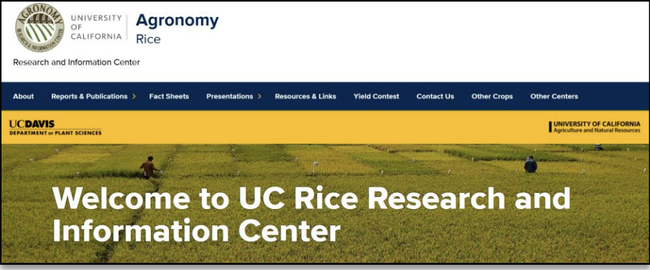
- Author: Luis Espino,
- Author: Ian Grettenberger
- Editor: Taiyu Guan
- Editor: Consuelo Baez Vega
In the past three years, there has been an increase in the number of reports of damage to rice by rice seed midge in the Sacramento Valley. During 2021 and 2022, the issue was not widespread, but there were some instances where the damage was severe. In 2023, several reports of damaged fields were received. We visited several of these fields with varying levels of injury in Colusa and Glenn Counties. One of these fields lost almost 20 acres to midge. Some of the damaged fields had received a pyrethroid treatment soon after seeding. While these insecticide applications may have provided some control in the past, it appears that may no longer be the case, and we are puzzled by the apparent inefficacy of the insecticide.
Rice seed midge survive in canals and ditches year-round. During spring, adults swarm, mate, and lay eggs on the surface of the water as fields are flooded. Eggs hatch after two days, and very small larvae swim to the bottom where they feed and build silken tubes that they use for protection. The tubes get covered with mud and algae and are easy to spot when the water is clear. The larvae initially feed on diatoms and algae and can start feeding on rice seeds and seedlings after around 5 days. After a few more days, larvae pupate, turn into adults, and repeat the cycle again.
Rice seed midge tubes near injured seeds
Injured seed with rice seed midge larva
When feeding on the germinating seed, larvae consume the embryo and endosperm, hollowing them out. Damaged seeds show an entrance hole in the hull near the embryo. Midge larvae can also clip the developing coleoptile or radicle, causing injury similar to tadpole shrimp. Hollowing of the seed and clipping the germinating structures will kill the seed. Once the coleoptile and radicle are well developed, midge injury is less likely to kill the seedling. Midge larvae also feed on larger seedlings. It is not uncommon for midges to perforate leaves; they may even attach their silken tubes to the seedling.
However, this type of injury does not kill the seedling. The best strategy to reduce the risk of injury by rice seed midge is to avoid planting too early or too late, avoid low or high temperatures during seeding, and seed soon after flooding. If injury is detected early enough and the field can be drained quickly, draining the field can reduce damage; however, injury can still occur in low areas of the field that do not drain completely. Planting high quality seed and maintaining an adequate flood can help seedlings establish quickly and avoid midge injury.
Lambda cyhalothrin, a common pyrethroid insecticide used for seedling pests in rice, has been used to manage rice seed midge. However, in recent years, we have noticed that some treated fields are still damaged by the midge. There is some evidence that indicates that midge larvae may not be as susceptible to this insecticide as we thought, possibly due to repeated applications of these insecticides through time. We are conducting field studies to confirm these observations and determine which insecticides could be used to help manage midge.
- Editor: Taiyu Guan
- Editor: Consuelo Baez Vega
Significant Thiobencarb Concentration Detections in Colusa Basin Drain.
The Rice Pesticide Program (RPP) will enter the 8th week of thiobencarb (i.e., Bolero, Abolish, Willowood Thio) monitoring on June 27. The results of monitoring across the sampling sites have generally yielded positive results with only two samples exceeding the performance goal of 1.5 μg/L to date.
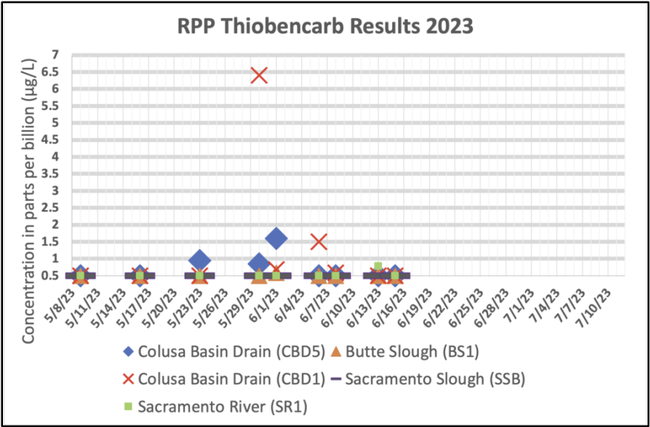
We continue to communicate with the County Agricultural Commissioner's offices, the Central Valley Water Board and the Department of Pesticide Regulation (and program stakeholders) to ensure they receive regular updates to the monitoring results and understand the support of the industry for use of their regulatory authority, including removing the use of thiobencarb from a grower/applicator permit.
As an industry we have the responsibility for the stewardship of this product. The Rice Commission will continue to fully implement the management practices approved by the Central Valley Water Board to promote compliance with the program requirements, including investigation of the source of exceedances.
For more information, contact the CRC's Industry Affairs Manager Craig Riddle at criddle@calrice.org or (916) 812- 3468.
- Editor: Taiyu Guan
- Editor: Consuelo Baez Vega
California Rice Field Day is scheduled for Wednesday, August 30, at the Rice Experiment Station (RES) in Biggs. The annual event provides growers and other interested parties a chance to see and discuss research in progress at the RES. In addition to the informational field tours and poster displays, a rice equipment vendor display is also being planned.
The event begins at 7:30 a.m. and concludes with lunch at noon.
The RES is located at 955 Butte City Highway, Biggs CA 95917
For more on Rice Field Day click here.
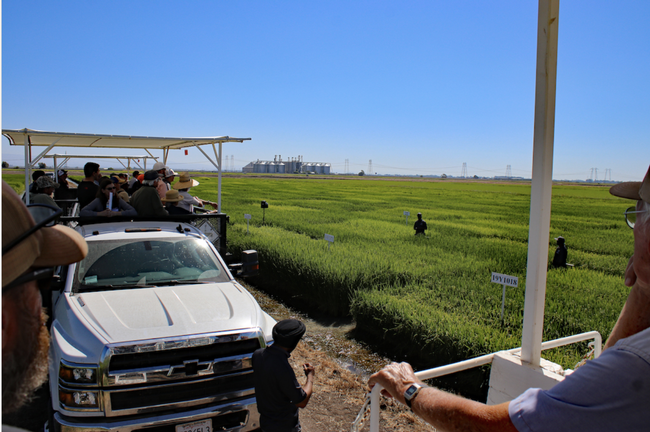
- Author: Ian M Grettenberger
- Author: Whitney Brim-DeForest
- Author: Luis Espino
- Author: Troy L Clark
- View More...
With rice pushing fully through the water and with many fields now a vibrant green, tadpole shrimp season has passed in California's rice fields. Fields that had tadpole shrimp eggs lurking in the soil would have had a flush of tadpole shrimp soon after fields were flooded, although insecticide applications or water management (drying the field) may have killed many off. There may still be lingering evidence of stand loss from fields that suffered tadpole shrimp damage. Most shrimp that were in fields will have cycled out at this point, laying their eggs over a few weeks and then dying. Nevertheless, our team is continuing to finish out our field work this year and conduct a number of lab and greenhouse studies aimed at developing an integrated management plan for tadpole shrimp. This project is ongoing, but it is worth covering some of the studies, research questions, and results thus far.
Tadpole shrimp are one of the key arthropod pests of rice in California. They can kill or damage germinating seeds/seedlings and can cause seedlings to uproot and drift away. Management typically entails insecticide applications, especially in conventional production. In organic systems, insecticide options are much more limited, although water management approaches (field dry down) can also help manage tadpole shrimp. While management itself is challenging, scouting and determining the risk of damage based on when a field is planted and environmental conditions can also be challenging. Furthermore, we do not currently have a great idea if tadpole shrimp, which are notably omnivorous, are also suppressing weed populations by feeding on germinating weeds. This could be an unrecognized benefit to having at least some tadpole shrimp in a field. Our project, funded by a CA Department of Pesticide Regulation grant, aims to develop new tools and approaches to tadpole shrimp management and to enhance our understanding of their ecology in rice fields to promote better management.
Damage potential of tadpole shrimp
One component of this project is to better understand the relationship or “arms race” between tadpole shrimp and rice. For both rice and tadpole shrimp, adding water starts the clock on their growth. We already know that quickly flooding fields and prompt planting can help reduce the likelihood of tadpole shrimp damage; this helps the rice grow out of the “damage danger zone” when rice is smaller and can be damaged by shrimp that are large enough to damage the rice. Fine tuning recommendations around these timings would help better predict when damage could occur. A field study at the Rice Experiment Station has already begun to do this. Across two years, we saw that damage was minimal to plantings seeded 2 or 3 days after flooding (seedling damage in Figure 2, 2021 stand count shown in Figure 3). However significant damage started to occur when fields were seeded 4 days after flooding. Waiting until 8 days after flooding was a sure-fire way to get extensive damage.
Figure 1. Field trials to examine the damage potential of tadpole shrimp at different seeding times.
Figure 2. Damage to seedlings in plots that were seeded at various time points after flooding and in two different trials. There were fewer points for the 8 DAF timing, but that was because seeds never even became seedlings.
Figure 3. Stand loss in plots that were seeded at various time points after flooding in the 2021 trial.
We are also investigating how shrimp density, which can vary, interacts with seeding time. Furthermore, we hope to better elucidate how both rice and shrimp respond to different temperatures and how this affects damage risk. During the spring, temperature can be highly variable. At times, it can be cool, while at other times it can be blisteringly hot. We anticipate that better understanding this relationship will be critical as we experience more early season hot spells.
Biological control
Another aspect of the project is to examine if biological control of tadpole shrimp could be a way to manage this pest. While all sorts of predators will eat different stages of tadpole shrimp, from aquatic insects like diving beetles to birds like ibis, these predators are difficult to manipulate. One type of fish, mosquitofish, may be a predator that could be manipulated that might suppress tadpole shrimp. We are in progress with our studies (including a number of field studies, Figure 5), but several key points have become apparent. First, the rate of fish is critical and may contribute to the success of this tactic. Higher stocking rates have reduced shrimp populations at times, but when fewer fish were added, they appear to not eat enough tadpole shrimp to be noticeable. These predators are generalists, so they likely are eating other types of arthropods within the plots. In addition, timing appears very important. Adding fish much after flooding/seeding, perhaps even between 1 and 3 days after seeding, could not give them enough time to eat the shrimp when they are still small. At some point, although we need to determine when, the fish will simply not be able to eat the rapidly growing tadpole shrimp.
Figure 4. Mosquitofish (Gambusia affinis, photo credit: Robert McDowall
Figure 5. Field plots used to examine the biological control potential of mosquitofish for tadpole shrimp management.
Weed management by tadpole shrimp?
In contrast to the rice damage they can cause, tadpole shrimp may actually provide weed management benefits. Our project is also evaluating the capacity of tadpole shrimp to feed on rice weeds. Growers and PCAs may benefit from a reduction on rice weeds establishment by allowing tadpole shrimp to feed on rice weeds when rice is not susceptible to injury. Biological control of rice weeds by tadpole shrimp would replace herbicide use, but it may help avoid weed escapes, which promote the development of herbicide-resistant weeds. Again, these studies are ongoing, but we have already made a few interesting observations, which will be solidified as we conduct and complete studies. Greenhouse studies (Figure 6) have shown that while tadpole shrimp will definitely consume and damage weed seedlings, the species identity of the weeds matters. Containers were treated like a small mesocosm and focused on specific weed species one at a time. There were containers for each weed species with either no shrimp or two different densities of shrimp. Tadpole shrimp readily consumed a number of broadleaved weed species like redstem, but appeared to not damage bulrush (Figure 7). Additional studies are examining the typical complement of weed species all at once. While tadpole shrimp may reduce weed populations in a field, ideally without damaging the rice, it seems like they may not damage all weed species.
Figure 6. Experimental setup for greenhouse study examining if tadpole shrimp will consume seedlings of different weed species.
Figure 7. Effect of tadpole shrimp (none on left container within each photo, with tadpole shrimp in center and right containers at two different densities). The left image shows the effect of tadpole shrimp on bullrush (minimal), while the right shows the effect on redstem (all consumed).
Towards improved IPM for tadpole shrimp
Overall, we hope that increased knowledge about how tadpole shrimp interact with rice and with weeds may help better target management tactics. Insecticides are widely used and often effective, but there may be ways to use them in a more targetted and effective manner. This is especially important given possible insecticide resistance issues for tadpole shrimp. Tadpole shrimp will likely remain a key arthropod pest in rice, so optimizing management plans will help manage these pests sustainably and effectively.
Funding for this project has been provided in full or in part through a Grant awarded by the Department of Pesticide Regulation


